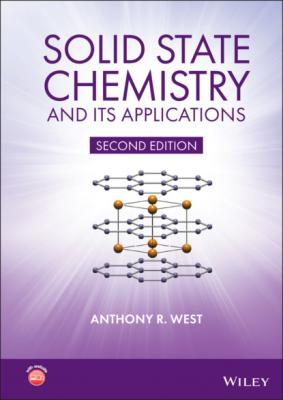Solid State Chemistry and its Applications. Anthony R. West
Читать онлайн.| Название | Solid State Chemistry and its Applications |
|---|---|
| Автор произведения | Anthony R. West |
| Жанр | Химия |
| Серия | |
| Издательство | Химия |
| Год выпуска | 0 |
| isbn | 9781118695579 |
Table of Contents
1 Cover
5 Preface
9 1 Crystal Structures, Crystal Chemistry, Symmetry and Space Groups 1.1 Unit Cells and Crystal Systems 1.2 Symmetry 1.3 Symmetry and Choice of Unit Cell 1.4 Lattice, Bravais Lattice 1.5 Lattice Planes and Miller Indices 1.6 Indices of Directions 1.7 d‐Spacing Formulae 1.8 Crystal Densities and Unit Cell Contents 1.9 Description of Crystal Structures 1.10 Close Packed Structures – Cubic and Hexagonal Close Packing 1.11 Relationship Between Cubic Close Packed and Face Centred Cubic 1.12 Hexagonal Unit Cell and Close Packing 1.13 Density of Close Packed Structures 1.14 Unit Cell Projections and Atomic Coordinates 1.15 Materials that can be Described as Close Packed 1.16 Structures Built of Space‐Filling Polyhedra 1.17 Some Important Structure Types 1.18 Point Groups and Space Groups
10 2 Crystal Defects, Non‐stoichiometry and Solid Solutions 2.1 Perfect and Imperfect Crystals 2.2 Types of Defect: Point Defects 2.3 Solid Solutions of Ionic Materials 2.4 Extended Defects 2.5 Dislocations and Mechanical Properties of Solids
11 3 Bonding in Solids 3.1 Overview: Ionic, Covalent, Metallic, van der Waals and Hydrogen Bonding in Solids 3.2 Ionic Bonding 3.3 Covalent Bonding 3.4 Metallic Bonding and Band Theory 3.5 Bands or Bonds: A Final Comment
12 4 Synthesis, Processing and Fabrication Methods 4.1 General Observations 4.2 Solid State Reaction or Shake ‘n Bake Methods 4.3 Low Temperature or Chimie Douce Methods 4.4 Gas‐Phase Methods 4.5 High‐Pressure Methods 4.6 Crystal Growth
13 5 Crystallography and Diffraction Techniques 5.1 General Comments: Molecular and Non‐Molecular Solids 5.2 Characterisation of Solids 5.3 X‐Ray Diffraction 5.4 Electron Diffraction 5.5 Neutron Diffraction 5.6 The Reciprocal Lattice 5.7 Total scattering and pair distribution function (PDF) analysis 5.8 Line broadening of XRD powder patterns, domain (particle) size measurement and strain effects
14 6 Other Characterisation Techniques: Microscopy, Spectroscopy, Thermal Analysis 6.1 Diffraction and Microscopic Techniques: What Do They Have in Common? 6.2 Optical and Electron Microscopy Techniques 6.3 Spectroscopic Techniques 6.4 Thermal Analysis (TA) 6.5 Strategy to Identify, Analyse and Characterise ‘Unknown’ Solids
15 7 Phase Diagrams and Their Interpretation 7.1 The Phase Rule, the Condensed Phase Rule and Some Definitions 7.2 One‐Component Systems 7.3 Two‐Component Condensed Systems 7.4 Some Tips and Guidelines for Constructing Binary Phase Diagrams 7.5
